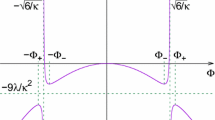Summary
When the quantum field, in the field-metric theory, is separated into its space-time and internal co-ordinate parts it is shown that the wave equations of the space-time part of the field are the established local wave equations, that free field wave equations describe the internal co-ordinate field whose quantum numbers are already determined, that the elementary particle selection rules are obtained from these quantum numbers and that the baryon meson mass spectrum can also be obtained from them. Then for non relativistic but physical boundary conditions two models are constructed according to two possible interpretations of the known baryon-meson mass spectrum and the mass spectra obtained from them are given in Tables II and III, both being in reasonable agreement with the known mass spectrum. Then it is indicated that the most characteristics feature of nonlocal theories considered here is the existence of sequences of resonances and estimates of succeeding resonances for the fermion-isofermion, fermion-isoboson, boson-isoboson and boson-isofermion fields are predicted for the two models.
Riassunto
Quando il campo quantistico, nella teoria della metrica dei campi, viene separato nelle sue parti di coordinate spazio-temporali e interne si dimostra che le equazioni d’onda della parte spazio-temporale del campo sono equazioni di onde locali stabilizzate, che le equazioni d’onda del campo libero descrivono il campo di coordinate interne i cui numeri quantici sono già determinati, che le regole di scelta delle particelle elementari si ottengono da questi numeri quantici e che da essi si può ottenere lo spettro di massa mesone-barione. Quindi si costruiscono, per condizioni ai limiti non relativistiche ma fisiche, due modelli, secondo le due possibili interpretazioni dello spettro di massa conosciuto dei mesoni-barioni, e gli spettri di massa così ottenuti, esposti nelle Tabelle II e III, sono entrambi in buon accordo con lo spettro di massa conosciuto. Poi si indica che la proprietà più caratteristica delle teorie non locali qui considerata è l’esistenza di sequenze di risonanze e si fanno, per i due modelli, alcune predizioni sui valori delle risonanze successive per i campi fermione-isofermione, fermione-isobosone, bosoneisobosone e bosone-isoformione.
Similar content being viewed by others
References
P. Sen:Nuovo Cimento,15, 513 (1960).
P. Sen:Nuovo Cimento,18, 613 (1960).
P. Sen:Nuovo Cimento,21, 710 (1961).
S. F. Tuan:Nuovo Cimento,23, 448 (1962).
M. Gell-Mann andF. Zachariasen:Phys Rev.,124, 953 (1961);M. Gellmann:Phys. Rev.,125, 1067 (1962).
P. T. Mathews andA. Salam:Nuovo Cimento,23, 453 (1962).
G. F. Chew andS. C. Frautschi:Phys. Rev. Lett.,7, 394 (1961);G. F. Chew, S. C. Frautschi andS. Mandelstam:Phys. Rev.,126, 1202 (1962).
P. Sen:Nuovo Cimento,3, 612 (1956);8, 407 (1958).
M. Gell-Mann andA. Pais:Proc. of the 1954 Glasgow Conference on Nuclear and Meson Physics (New York, 1955).
P. Sen:Nuovo Cimento,13, 1122 (1959).
Author information
Authors and Affiliations
Additional information
Traduzione a cura della Redazione.
Rights and permissions
About this article
Cite this article
Sen, P. Metric fields.. Nuovo Cim 27, 575–588 (1963). https://doi.org/10.1007/BF02784564
Received:
Published:
Issue Date:
DOI: https://doi.org/10.1007/BF02784564



